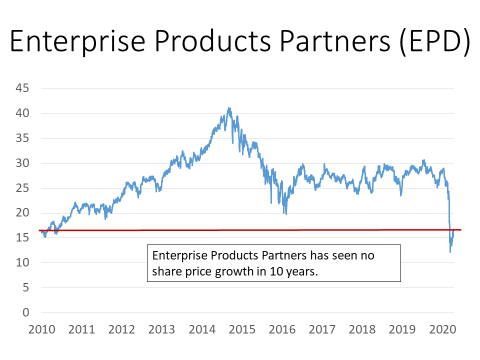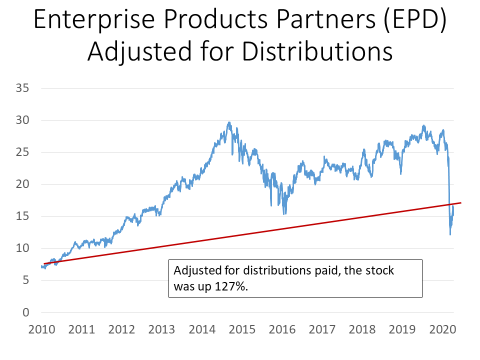The following first appeared on Money & Markets.
I probably don’t need to tell you 2020 has been a rough year for the stock market. Even after a spectacular rally, the S&P 500 is still down close to 20% on the year. And frustratingly for a lot of income investors, high-yielding dividend stocks generally thought of as “safe” were some of the hardest hit.
I should know. I have a portfolio full of them, and some are still down more than 50%.
From 5% to 7% is considered a really high yield for dividend stocks these days. But is it worth risking a 50% decline in order to squeak out a single-digit yield?
I’ll answer my own question with an emphatic “yes.”
And to prove my point, I’ll use one of my very favorite long-term income machines, Energy Products Partners (NYSE: EPD). Enterprise owns one of the largest networks of natural gas and natural gas liquids pipelines in the country. It has an excellent management team.
Enterprise Products is an MLP and pays “distributions” rather than “dividends.” But for our purposes here, that’s a distinction without a difference. Enterprise Products is a dividend stock, and a fine one at that. The MLP yields a whopping 11.3% and has raised its payout every year since 1998.
Still, it’s been a rough road for this pipeline blue chip. The stock got slapped down during the 2015-16 oil crash and then was utterly obliterated during the March coronavirus meltdown and corresponding collapse in energy prices.
Today, the shares trade at 2010 prices.

An investor holding Enterprise Products over the past 10 years — through one of the most explosive bull markets in history — wouldn’t have earned a single red cent … unless, of course you consider reinvested dividends. Taking into account reinvested dividends gives us a very different picture.
During one of the most difficult decades in history for energy-relative stocks, Enterprise Products managed to return about 127%.

Sure, that’s a lot less than the S&P 500. But that’s not the point here. The takeaway is that high-dividend stocks can still be fantastic investments even during extremely rocky periods.
Consistent dividend payers are getting harder to find these days. Already, about 5% of the stocks in the S&P 500 have reduced or eliminated their dividends since the onset of the coronavirus scare, and we’re not done yet. The longer the lockdowns stay in effect, the more dividend cuts I expect to see. Goldman Sachs recently forecast that S&P 500 companies would spend 23% less on dividends this year.
So, you shouldn’t just buy a stock based on its yield and hope for the best. You need to be confident that the business supporting the dividend is healthy and sound.
As an interesting aside, the single biggest buyer of S&P 500 stocks over the past decade has been the companies themselves. It’s debatable exactly how much of the market’s epic run since 2009 was due to buybacks alone, but it’s safe to say it was substantial.
S&P 500 companies bought back $5.5 trillion of their own stocks between 2009 and 2019.
That’s trillion. With a T.
That represents about a fifth of the entire market cap of the S&P 500.
With a given pool of investors fighting over a shrinking pool of available stock to buy, prices had nowhere to go but up.
That came to a screeching halt with coronavirus. Companies are rightly hoarding cash. And Congress has effectively banned buybacks for any company taking federal assistance (which they should have!) Goldman Sachs expects buybacks to fall by about 50% this year.
One of the biggest drivers of stock returns — buybacks — is going to be on ice for the foreseeable future. This actually makes dividends all the more important. If we can’t depend on general asset price inflation, then we’ll have to settle for getting paid in cold, hard cash.
This article first appeared on Sizemore Insights as Are Dividend Stocks Still Worth Owning?
